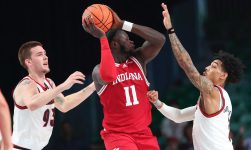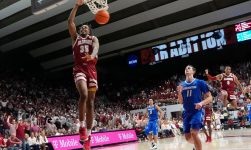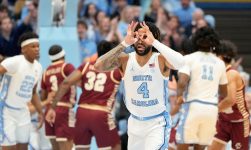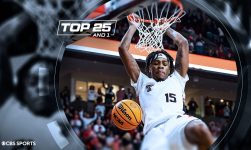When freshmen Dylan Harper and Ace Bailey walk into Rutgers’ Trapezoid of Terror for the Scarlet Knights’ home opener, they’ll make history. The five-star prospects are the highest two recruits to ever suit up for Rutgers.
It’s a trailblazing duo, but they’re far from alone.
Cooper Flagg is the best recruit Duke has landed in the history of modern recruiting rankings. Baylor’s VJ Edgecombe, Miami’s Jalil Bethea, Arizona State’s Jayden Quaintance, BYU’s Egor Demin and Illinois’ Will Riley will also have that stamp as the program’s top-rated recruit in the internet era.
Alabama’s Derrion Reid, Maryland’s Derik Queen and Syracuse’s Donnie Freeman are each the second-highest-rated recruits for their respective clubs.
Call it an intended benefit of the influx of Name, Image and Likeness revolution. There will always be haves and have-nots in college basketball, but programs like BYU and Arizona State –– who own zero Final Four appearances ever, combined –– now have the resources to recruit some of the best prospects in the world.
But the situation is everything, even for some of the best recruits in the country who hope to be in college for one year before signing lucrative NBA paychecks. Let’s dive into some of the bigger scheme questions surrounding all 20 five-star recruits from the highly-anticipated Class of 2024.
Realistic expectation: Starting forward
Burning college question: Will Duke’s frontcourt have enough spacing around Flagg?
Duke is poised to try and play Flagg, Syracuse transfer Maliq Brown and enormous center Khaman Maluach together to give the defense some insane rim protection, absurd court coverage and ridiculous length. If Tyrese Proctor and Tulane transfer Sion James are also on the floor, that’s a hellacious defensive quintet that can challenge Iowa State or Houston for the best defense in the sport.
But Duke’s best defensive lineup does not feature a ton of shooting. Brown made just seven triples combined in two years at Syracuse. Maluach has some floor-stretching potential, but it could take some time. Smart defenses could shrink the floor and clog some of Flagg’s driving lanes and playmaking opportunities. If that happens, will Scheyer be comfortable sacrificing some of that defensive thump for some added spacing? Make no mistake, there’s plenty of shooting on this roster, but a ton of it is coming off the bench if Maluach, Brown and Flagg are on the floor together.
It’s not impossible to be elite offensively with two extremely low-volume shooters on the floor (just ask UConn), but it requires precise execution and usually, an exceptional transition offense. That blend of offense versus defense will be a fun wrinkle for this Duke staff to parse, experiment and put to the test.
Realistic expectation: Starting wing
Burning college question: Can Bailey avoid falling in love with tough 2-pointers?
Bailey can make any shot on the floor, but just because you can make it, doesn’t make it a good shot. The Big Ten is widely regarded as one of the most well-scouted leagues in college basketball, and opposing defensive coordinators will have plenty of tricks up their sleeves to make Bailey’s life tough. He undoubtedly will give Rutgers some tantalizing flashes, but those stepback, one-foot, fadeaways can be both a blessing and a curse. It might come down to trust and embracing giving it up, so he can get it back in an even better position to be effective. Rutgers will feature multiple lineups with both Jeremiah Williams and Dylan Harper on the floor, and both of those lead guards are unselfish creators who should be able to bend defenses and create some of those long closeouts for Bailey to attack.
Realistic expectation: Starting guard
Burning college question: Can Harper breathe life into a dormant Rutgers transition offense?
Steve Pikiell’s well-schooled defenses defend action after action, dwindling the shot clock and forcing tough late-clock attempts. As a result, Rutgers has rated outside the top-200 nationally in adjusted tempo in six of Pikiell’s eight years at Rutgers. But Rutgers quietly ran a bunch last year, partially because its halfcourt offense was a trainwreck. Rutgers had the fourth-highest transition rate in the Big Ten, per Synergy, and that shouldn’t be an anomaly. If anything, Rutgers may want to ramp the pace up even more with Harper leading the charge. Harper is an excellent rebounder and a willing push-ahead passer. His ability to grab and go should open up opportunities for Bailey to put on aerial displays that defy gravity.
Realistic expectation: Starting center
Burning college question: Is the face-up skill going to be a thing?
Maluach is a 7-foot-2, 250-pound big man who is armed with a 9-8 standing reach. But Maluach isn’t just a skyscraper. Maluach is an enticing NBA Draft prospect because of his burgeoning face-up skills. During his stint with the City Oilers in the Basketball Africa League, Maluach flashed some of his bag, including a feathery midrange jumper and the knack to fake a dribble hand-off and get to the tin in a hurry. Some staffers believe Maluach has the highest ceiling on the Duke roster, including Flagg. Will the skill come to fruition at Duke? Smart defenses might send a second defender at him the moment he puts it on the ground to try and force turnovers. Can he handle the speed of the game and can he show the ability to decipher defenses and make simple reads? If so, Maluach could stick in both Duke’s starting lineup and its closing lineup.
Realistic expectation: Starting guard
Burning college question: Is a heavy diet of pick-and-rolls on tap?
Only three teams in college basketball ran more pick-and-rolls last year than Baylor. Maybe that comes down a tad in 2024-25 with a pick-and-roll maestro like RayJ Dennis and a rim-runner like Yves Missi off to greener pastures, but it’s clear that Baylor will use ball screens to generate offense at a high clip. Duke transfer Jeremy Roach is on the inside track to sop up most of those pick-and-roll reps, but Edgecomb, a five-star guard, will have an opportunity to do the same.
Edgecombe’s guard skills are still a work in progress. He’s more of a scorer than a playmaker at this point. Edgecombe should be able to use that lightning-quick first step to get into the paint at will. Baylor should be able to feature multiple five-shooter lineups, especially when Norchad Omier and Jalen Celestine are in the frontcourt, so the paint will be open for Edgecombe’s turbo drives. Edgecombe-to-Baylor is almost a perfect fit, but how quickly he gets up to speed in the pick-and-roll game could go a long way in cementing Baylor’s case as a national championship contender because Roach can’t do it alone.
Realistic expectation: Starting wing
Burning college question: Can Johnson get to the rim?
Johnson is a bucket from downtown and the midrange, but finishing at the rim is still a work in progress for the five-star wing. Johnson shot just 43.5% at the rim at Link Academy last year in halfcourt settings, per Synergy, and it wasn’t on high volume either. Just 15% of Johnson’s halfcourt attempts came at the rim.
That could be a problem in the SEC, hands down the best shot-blocking league in America. The SEC has led all conferences in block percentage in three of the last four seasons, per KenPom. Johnson is walking into a hornet’s nest, and his situation doesn’t alleviate many of the concerns.
Getting to the rim just hasn’t been a big priority for Rodney Terry’s teams in the past. Texas finished 334th and 348th nationally in Shot Quality’s Rim & 3 rate during Terry’s first two seasons, and new Longhorn guards Tramon Mark and Jordan Pope both had startling low rim rates last year. That’s who Johnson is slated to start next to in this Texas backcourt.
Johnson’s pure stroke may have to be the trump card, but relying on jump shot roulette in this bear of a league sounds hellacious. Will Texas make tweaks to its offensive philosophy to maximize its five-star freshman?
Realistic expectation: Starting guard
Burning college question: Can Bethea be a true, three-level scorer?
Bethea might be the best shooter in this class. Both Bethea and Miami star guard Nijel Pack have “in the gym” range, and it should give serious gravity and extra spacing to a Miami offense that needs to get better in a hurry if it wants to get back to the Big Dance. Miami certainly needs to generate more rim pressure and get to the charity stripe more often. Miami had one of the lowest free-throw rates in the sport last season, and its top foul-drawer (Norchad Omier) transferred to Baylor. There’s a good chance Bethea’s jumper sticks. It’s just what he does. But adding more polish to his game with some extra drives would be good for his long-term NBA Draft stock and a huge boon for Miami’s halfcourt offense.
Realistic expectation: Potential starting guard
Burning college question: How does Ian Jackson fare playing off the ball?
There are some concerns about Jackson’s jumper after he shot just over 28% from 3-point range as a senior, but it might be a touch overblown. Jackson attempted over seven 3-pointers per game at Overtime Elite, and his tape is littered with a bunch of off-the-dribble 3-pointers which could have sunk his overall percentages a tad.
With RJ Davis and Elliot Cadeau handling so much of the on-ball creation, Jackson should be able to avoid those inefficient, off-the-dribble 3-pointers. Jackson is too competent of a shooter to be “dorked” and sagging off him would give the dynamic, 6-5 guard even more of a runway to get downhill in a hurry. How Jackson finds ways to be a threat off the ball will be fascinating. He’s a good cutter who finds open seams. Jackson can attack those second-side pick-and-rolls. Hiding your worst perimeter defender on Jackson wouldn’t be wise because he’s a walking paint touch who can constantly put opposing defenses into crisis mode.
UNC has to find creative ways to weaponize a winner like Jackson, like potentially using him as a guard-on-guard screener to mismatch hunt.
Jayden Quaintance is the best recruit Arizona State has ever landed in the history of modern recruiting rankings
Realistic expectation: Potential starting center, frontcourt rotation
Burning college question: Will a 17-year-old freshman embrace the dirty work?
Quaintance has a sky-high ceiling and should be a lottery pick one day because he’s armed with a 7-3 wingspan and has every tool you could want for a big man. But Arizona State has no shot to be competitive in the Big 12 if it doesn’t rebound. The Sun Devils got gauged on the glass last season, and the Big 12 is filled with teams who make chasing down offensive rebounds a huge part of their game plans and identities. It’s a non-negotiable for programs like Houston, TCU and Cincinnati. Same thing goes for Arizona. Quaintance’s eye-popping plays will be dazzling, but his motor on the glass is a massive X-Factor for Arizona State to survive in its new home.
Realistic expectation: Starting wing
Burning college question: Is the conditioning where it has to be?
Hopefully, McNeeley is ready to run because Dan Hurley’s layered offense is going to have him zooming up and down the floor in transition and also flying in and around screens to find openings for treys. McNeeley is best suited to step into the role as the top off-movement shooter for this UConn roster. It’s a tough task for anybody, especially a freshman, but McNeeley won’t be tasked with doing something he’s not capable of executing. Hurley’s ability to cover up weaknesses and maximize strengths might be more beautiful than his intricate halfcourt sets. Hopefully, McNeeley’s got some track shoes in his locker because he’ll need ’em.
Realistic expectation: Wing rotation, potential starter
Burning college question: How quickly can Powell become UNC’s wing-stopper?
Powell might be a big part of the solution for a UNC defense that may always have some size limitations with Elliot Cadeau and RJ Davis on the floor together. Powell, a 6-6, 195-pound wing, covers so much ground, vertically and horizontally, and is routinely lauded for his high IQ and attention to detail on the scouting report.
Defense is the way for Powell to become hard to take off the floor. It also can make him stand out amidst UNC’s crowded wing corps. There are real questions about whether Belmont transfer Cade Tyson can be up to snuff with his on-ball defense against high-major wings. He might be better-utilized defensively guarding off-ball wings or chasing around shooters.
If UNC wants to get past Duke and its crowded batch of wings, it needs a defensive kingpin. Powell can be UNC’s answer to the test.
Realistic expectation: Starting big man
Burning college question: Are a boatload of dribble handoffs coming?
New Maryland starting point guard Ja’Kobi Gillespie was one of the most efficient scorers in the country last year at Belmont using hand-offs. Kevin Willard should be able to build off that thanks to the addition of Queen. The husky five-star big man should provide a handy dribble handoff partner for Gillespie to skitter around to find creases in the defense. Queen is a tantalizing passer (with both hands), and there’s optimism that Maryland can use him as a facilitator at the top of the key. Plenty will be made, for good reason, about his fit next to another non-shooting big man like Julian Reese, but Queen’s chemistry with Gillespie might be even more important. If they can establish a good rapport in that dribble handoff game, Maryland can still find ways to create good shots even with real shooting questions on this roster.
Realistic expectation: Wing rotation
Burning college question: How can Evans stand out amidst a crowded roster?
Through his first two seasons at the helm, Jon Scheyer has typically played seven or eight guys a night. Let’s assume that sticks in 2024-25:
Cooper FlaggTyrese ProctorCaleb FosterSion JamesMaliq BrownKhaman MaluachKon KnueppelMason Gillis
The minutes math gets cloudy quickly for a five-star wing like Evans. Unfortunately, injuries are a thing (as Duke has learned the hard way in the last few seasons), but at full strength, it will not be easy for Evans to crack this rotation. The case for playing time is simple: Evans’ tough shot-making ability is too potent to keep him on the bench. Duke, for all its obvious strengths, does not have that locked-in closer who can create a bucket late in the shot clock. Maybe it’s Flagg, Foster, Proctor or Knueppel. Maybe it can be Evans?
Realistic expectation: Frontcourt rotation
Burning college question: Can Kansas play Bidunga and Hunter Dickinson together?
Bill Self is already tinkering with the idea of pairing Dickinson, a polished fifth-year vet, with Bidunga, a physical, raw freshman. Dickinson’s passing chops and floor-spacing ability opens up the opportunity for Bidunga to operate as a rim-running lob threat who can be a play-finisher when Dickinson gets double-teamed. Defensively, Dickinson’s struggles in space are well-documented and he’s more of a rim deterrent, not a rim protector. Bidunga might be the opposite. The five-star freshman owns a 7-2 wingspan and incredible vertical bounce. He’s only 6-8 but Bidunga plays way bigger than that.
Bidunga is probably best-suited to be the backup 5-man behind Dickinson while KJ Adams Jr. and AJ Storr sop up most of the minutes at the 4, but a Bidunga-Dickinson pairing might be a tool in the garage for Self to whip out at the right time.
Realistic expectation: Starting 4-man
Burning college question: How much rim protection can Freeman bring to Syracuse?
Syracuse’s defense was a sieve in conference play. ACC foes shot a whopping 55% on 2s against Syracuse last winter. That was the worst mark in the league. Two newcomers will get the first shot at buffing up Syracuse’s shoddy interior defense: Colorado transfer Eddie Lampkin and five-star forward Donnie Freeman. But Lampkin isn’t a vertical rim protector. The burly, 6-11, 265-pound center had just a 0.5 block percentage last season which was the lowest of any starting center in the Pac-12.
Freeman’s value to Syracuse skyrockets if he’s a legit deterrent on the backline.
Realistic expectation: Starting wing
Burning college question: So, uh, what about the defense?
The Big 12 was one of the oldest, high-major leagues in the country last year. Just six freshmen played more than 20 minutes per game. The league is changing, but paying up for vets sure has not. BYU and Arizona State are the lone programs in the league with multiple freshmen positioned to start. Demin, a 6-9, Russian star, is expected to shoulder a bunch of the on-ball work for new BYU coach Kevin Young, but how ready is he defensively?
Johnny Furphy could be an example to watch. Furphy came to Kansas from Australia and worked his way into the starting lineup, but he was put into the spotlight repeatedly by opposing offensive coordinators who hunted him out defensively from the jump. If they did it to Furphy, they’ll do it to Demin, too. The 190-pound wing is probably best suited using his length to bother shooters on the perimeter, but the Big 12 is filled with outstanding guards who will try to find a weak link in the defense. Is Demin up to snuff defensively?
Realistic expectation: Starting wing
Burning college question: How does Nate Oats mix his best defensive lineup with his best five offensive players?
It’s hard to overstate how much better Alabama should be defensively with a shot-swatting big man like Cliff Omoruyi on the back line and a sturdy, lengthy wing like Reid who can cover a bunch of ground on the perimeter. But Alabama’s fire-breathing offense hums with lineups featuring four or five shooters. Alabama’s best defensive lineup might not have that. Omoruyi is not a threat to space the floor, Grant Nelson’s jumper comes and goes and Reid’s floor-stretching ability is shaping up to be the five-star freshman’s biggest X-Factor after he shot 31% from 3-point range on 54 attempts at Prolific Prep last season, per Synergy.
It might be a delicate push-pull for Oats all year because of the depth and lineup flexibility Alabama has amassed. There are lineup options galore for maybe college basketball’s deepest roster. But Reid can make it a moot point if the defensive impact is legit and the shooting comes along because he, simply, looks different than most of the other pieces on this roster.
Kon Knueppel is not the most hyped Duke freshman, but Jon Scheyer might have to clear room in the depth chart for him.
Getty Images
Realistic expectation: Wing rotation
Burning college question: Can Knueppel unlock a new lever for Duke’s offense?
Duke has rarely used post-ups for guards or wings during the first two years of the Jon Scheyer era. But that might just be roster-related, not Scheyer’s staunch philosophy. Knueppel may change that alone. The wide-bodied, 6-7 wing has the frame to be a terrific bootyball option who can be a mismatch hunter in the paint and create advantages for Duke to attack in the halfcourt.
Numerous smart, efficient offenses have started to use guards or wings as post-up weapons to invert the floor. Penn State, famously, used it with All-American point guard Jalen Pickett. Illinois’ elite offense was fueled by a heavy dose of post-ups for All-Big Ten wing Marcus Domask. Tennessee started using All-American Dalton Knecht as a bootyball machine. Duke saw a version of it up close and personal with UNC’s Harrison Ingram this past season.
The shooting can get Knueppel on the floor, but Duke may have to copycat some of that bootyball with him, too.
Realistic expectation: Starting forward
Burning college question: How quickly does the pick-and-pop game coalesce?
Georgia shot a billion 3-pointers last season, but it didn’t have a true pick-and-pop threat. Consider that problem solved with five-star Asa Newell on the way to Athens. The 6-9, 205-pound forward has all the tools to be an NBA player one day, but his silky lefty jumper should give Georgia’s offense some extra gravity and maximize the impact of sophomore lead guard Silas Demary. Last season, the Dawgs rated in just the 28th percentile in pick-and-roll efficiency, per Synergy, partially because it didn’t have a scary pick-and-pop threat. Georgia rollers made just five 3-pointers all season long. UGA’s bigs just weren’t a threat to stretch the floor.
Newell is.
Realistic expectation: Wing rotation, potential starter
Burning college question: What’s the shot diet?
Illinois might have the most analytically-tilted offense in the Big Ten. No Big Ten team had a higher “Rim & 3” rate than Illinois last year, per Shot Quality. The Illini also have a “shot selection game” that it plays to illustrate good versus bad shots. Illinois liked taking a bunch of treys and shots at the rim, especially in transition. Conversely, it rarely took off-the-dribble jumpers. The Illini had the lowest off-the-dribble jumper rate in the Big Ten last season. And here comes Riley who has flashes of being an exceptional off-the-dribble shotmaker. Riley takes (and makes) those tough shots that Illinois would rather avoid. The Illini and Riley will likely have to meet in the middle. Riley embracing Illinois’ shot selection game could help his efficiency spike. Brad Underwood embracing Riley’s off-the-dribble strengths could give the Illini a late-clock, get-out-of-jail-free card.
Finding that right balance will be everything.






